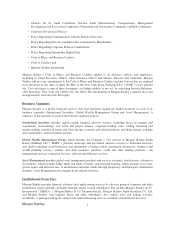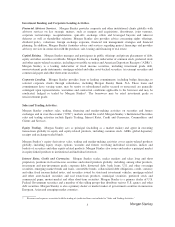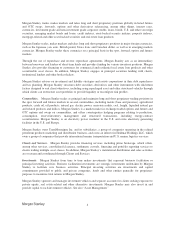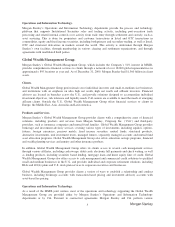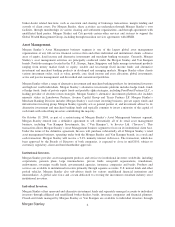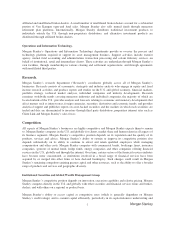Morgan Stanley 2009 Annual Report Download - page 16
Download and view the complete annual report
Please find page 16 of the 2009 Morgan Stanley annual report below. You can navigate through the pages in the report by either clicking on the pages listed below, or by using the keyword search tool below to find specific information within the annual report.
FDIC Regulation. An FDIC–insured depository institution is generally liable for any loss incurred or expected
to be incurred by the FDIC in connection with the failure of an insured depository institution under common
control by the same bank holding company. As FDIC-insured depository institutions, Morgan Stanley Bank,
N.A. and Morgan Stanley Trust are exposed to each other’s losses. In addition, both institutions are exposed to
changes in the cost of FDIC insurance. In 2009, the FDIC levied a special assessment of 5% on each insured
depository institution’s assets, minus its Tier 1 capital, capped at 10% of its domestic deposits. In addition, the
FDIC required insured institutions to prepay their estimated quarterly risk-based assessments for the fourth
quarter of 2009 and for all of 2010, 2011 and 2012. The FDIC also adopted a uniform three-basis point increase
in assessment rates effective on January 1, 2011. All measures were part of an effort to rebuild the Deposit
Insurance Fund. In addition, by participating in the FDIC’s Temporary Liquidity Guarantee Program, Morgan
Stanley Bank, N.A. and Morgan Stanley Trust have temporarily become subject to an additional assessment on
deposits in excess of $250,000 in certain transaction accounts. Some of the pending legislative proposals would
further increase Morgan Stanley’s FDIC assessments, which, if enacted, may materially affect Morgan Stanley’s
financial condition, results of operations and cash flows for a particular future period.
Anti-Money Laundering.
Morgan Stanley’s Anti-Money Laundering (“AML”) program is coordinated on an enterprise-wide basis. In the
U.S., for example, the Bank Secrecy Act, as amended by the USA PATRIOT Act of 2001 (the “BSA/USA
PATRIOT Act”), imposes significant obligations on financial institutions to detect and deter money laundering
and terrorist financing activity, including requiring banks, bank holding company subsidiaries, broker-dealers,
future commission merchants, and mutual funds to identify and verify customers that maintain accounts. The
BSA/USA PATRIOT Act also mandates that financial institutions have policies, procedures and internal
processes in place to monitor and report suspicious activity to appropriate law enforcement or regulatory
authorities. Financial institutions subject to the BSA/USA PATRIOT Act also must designate a BSA/AML
compliance officer, provide employees with training on money laundering prevention, and undergo an annual,
independent audit to assess the effectiveness of its AML program. Outside the U.S., applicable laws, rules and
regulations similarly subject designated types of financial institutions to AML program requirements. Morgan
Stanley has implemented policies, procedures and internal controls that are designed to comply with AML
program requirements. Morgan Stanley has also implemented policies, procedures, and internal controls that are
designed to comply with the regulations and economic sanctions programs administered by the U.S. Department
of the Treasury’s Office of Foreign Assets Control (“OFAC”), which enforces economic and trade sanctions
against targeted foreign countries, entities and individuals based on U.S. foreign policy and national security
goals, and other multi-national organizations and governmental agencies worldwide.
Anti-Corruption.
Morgan Stanley is subject to the U.S. Foreign Corrupt Practices Act (“FCPA”), which prohibits offering,
promising, giving, or authorizing others to give anything of value, directly or indirectly, to a non-U.S.
government official in order to obtain or retain business or otherwise secure a business advantage. Morgan
Stanley is also subject to applicable anti-corruption laws in the jurisdictions in which it operates. Morgan Stanley
has implemented policies, procedures, and internal controls that are designed to comply with the FCPA and other
applicable anti-corruption laws, rules, and regulations in the jurisdictions in which it operates.
Protection of Client Information.
Many aspects of Morgan Stanley’s business are subject to legal requirements concerning the use and protection
of certain customer information, including those adopted pursuant to the Gramm-Leach-Bliley Act and the Fair
and Accurate Credit Transactions Act of 2003 in the U.S., the European Union Data Protection Directive in the
EU and various laws in Asia, including the Japanese Personal Information (Protection) Law, the Hong Kong
Personal Data (Protection) Ordinance and the Australian Privacy Act. Morgan Stanley has adopted measures
designed to comply with these and related applicable requirements in all relevant jurisdictions.
12


